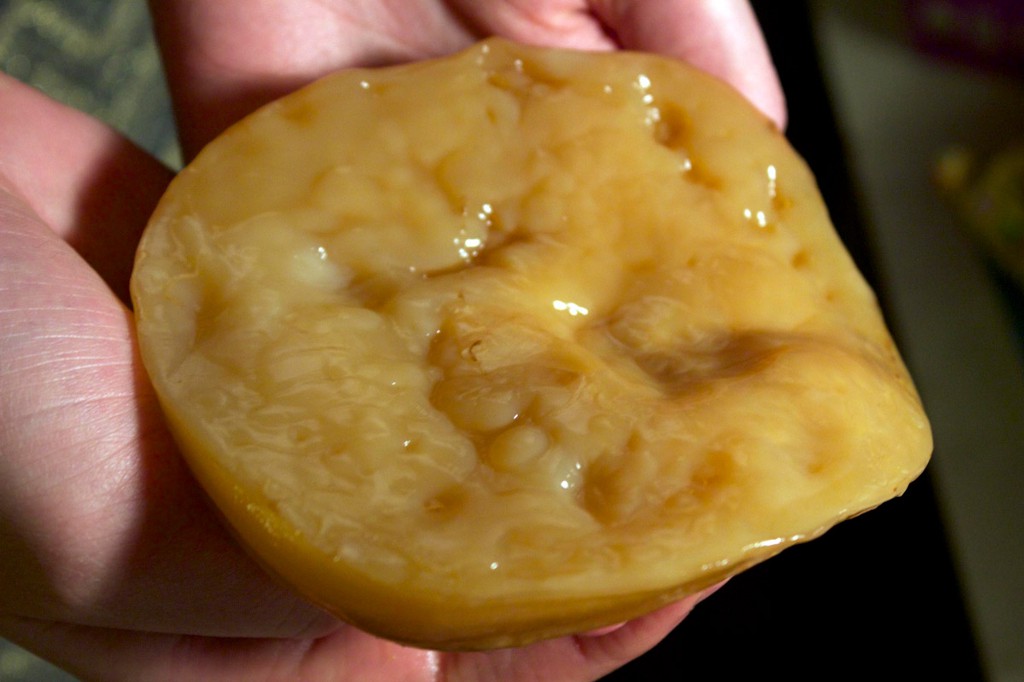Hipster tea sludge is being transformed into a wonder material.
When I unseal the envelope and put my nose under the flap for a recklessly deep sniff, the smell hits me like a punch to the gullet. I recognize it from a long-ago, and nauseating, visit to a penicillin factory. It’s the smell of microbes doing their private work, magnified to human scale. But the crisp sheets that have come in the mail from California aren’t medicine. They’re the dried residue of kombucha tea.
Kombucha is a trendy fermented drink. To brew it, you start with sugared tea and add a rubbery mat called a scoby, kind of like a sourdough starter. Scoby stands for “symbiotic culture of bacteria and yeast” and looks like a huge wad of snot. Some of the bacteria in this floating ecosystem naturally manufacture cellulose, the fiber that makes up paper and cotton. If you dry out a scoby, you get a tough, versatile, and Earth-friendly material that has the potential to shake up fashion and other industries.
My envelope of “kombucha leather,” or bacterial cellulose, came from UC Davis design professor Christina Cogdell. She’s co-teaching a class with biomedical engineering professor Marc Facciotti in which student teams are experimenting with applications for kombucha leather. At the end of the school year, they’ll send a team to the Biodesign Challenge.
Over a video chat, Cogdell shows me stacks of tubs growing scoby in her office. It’s also possible to isolate cellulose-making bacteria and use them to grow the material on their own, without the other members of a scoby community; some of Cogdell and Facciotti’s students will use the isolated strain Komagataeibacter xylinus. No one knows exactly why certain bacteria make cellulose. It might be to keep the microbes floating near the surface of their environment where there’s more oxygen, or to protect them from ultraviolet light. Whatever its purpose, bacterial cellulose is purer than cellulose made by plants, which can contain other molecules like lignin and pectin. Left on their own to dry, Cogdell’s microbial mats will turn into stiff sheets, not unlike an untreated animal hide.
Imagine clothing with a repair patch that you could keep alive in the fridge, then stick onto a damaged item.
Cogdell learned how to grow bacterial cellulose from Sacha Laurin, a former cheesemaker who runs a business called Kombucha Couture in Davis, California. Laurin has exhibited her fashion designs at shows in Paris and elsewhere. They include dresses, skirts, and bikini tops; the material has a semi-translucent quality that gives the clothing an alien-meets-caveperson vibe.
“I love that it is pure cellulose, a building block of life itself, that is spun by microbes,” Laurin says. She adds that people feel “magical and like a god or goddess” when they wear her clothes. Laurin also likes that the material is a kind of sustainable leather substitute — it’s totally biodegradable and animal-free. Wet layers will seal themselves together seamlessly. She imagines one day selling clothing with a repair patch that you could keep alive in the fridge, then stick onto a damaged item.
Students in the UC Davis class are experimenting with many aspects of bacterial cellulose. One is rubbing the material with different substances as it dries to soften it. Other students are working on making clothing, grocery bags, water pitcher filters, diapers, and tampons. In labs elsewhere, scientists are turning bacterial cellulose into paper and artificial skin. An American company already sells bacterial cellulose for wound dressing.
The cellulose fibers made by bacteria are thinner and stronger than cellulose fibers from plants, and extremely absorbent. That’s why the material has potential for feminine hygiene products. Unfortunately, that’s also why you can’t wear kombucha leather out in the rain. At the end of her 2011 TED talk, kombucha leather pioneer Suzanne Lee remarked that the vest she had on was absorbing her sweat and disintegrating in front of the audience’s eyes.

Even if you keep your kombucha clothing dry, its lifespan might be only six months. “It just wants to break down like a fresh leaf becomes old and brittle,” Laurin says. She suggests that people who buy her custom pieces clean them with baby wipes. But she thinks a more durable, machine-washable version would appeal to a wider audience. Scaling up the production is also a challenge to making kombucha leather more mainstream. Cogdell says it takes two to three weeks to grow a thick piece in one of her tubs.
There’s already an industry producing bacterial cellulose at large scales — although not for clothing. In the Phillipines, coconut water is fermented with cellulose-making bacteria to make a chewy jelly dessert called nata de coco. But Tom Ellis, a synthetic biologist at Imperial College London, thinks the textile version needs some tweaks before it will be mass produced. “In its current form it doesn’t offer anything substantially better or different” than traditional textiles like cotton or leather, Ellis says.
That’s why he’s researching ways to genetically and chemically engineer the material. To demonstrate how tweaking the microbes’ genes can change the fabric, he and colleagues recently engineered bacteria to make their cellulose with a green fluorescent protein. The resulting fabric is pale chartreuse in regular light, and glows under blue light. Besides building in dyes, scientists could add anti-microbial molecules to bacterial cellulose for bandages, or engineer it to better conduct electricity. “If we can produce a version of bacterial cellulose with exciting new properties never seen with leather, cotton or synthetic fibers, then it holds real promise beyond just being an interesting fad,” Ellis says.
As for the smell, some people don’t mind it. At UC Davis, Facciotti says, “the lab now has a new fragrance.” He and Cogdell have found that treating the material with sodium hydroxide helps. Laurin rubs her kombucha leather with proprietary oil blends. But she says more and more people tell her they actually love the smell. Maybe, like real leather, it will become more pleasant with familiarity.












